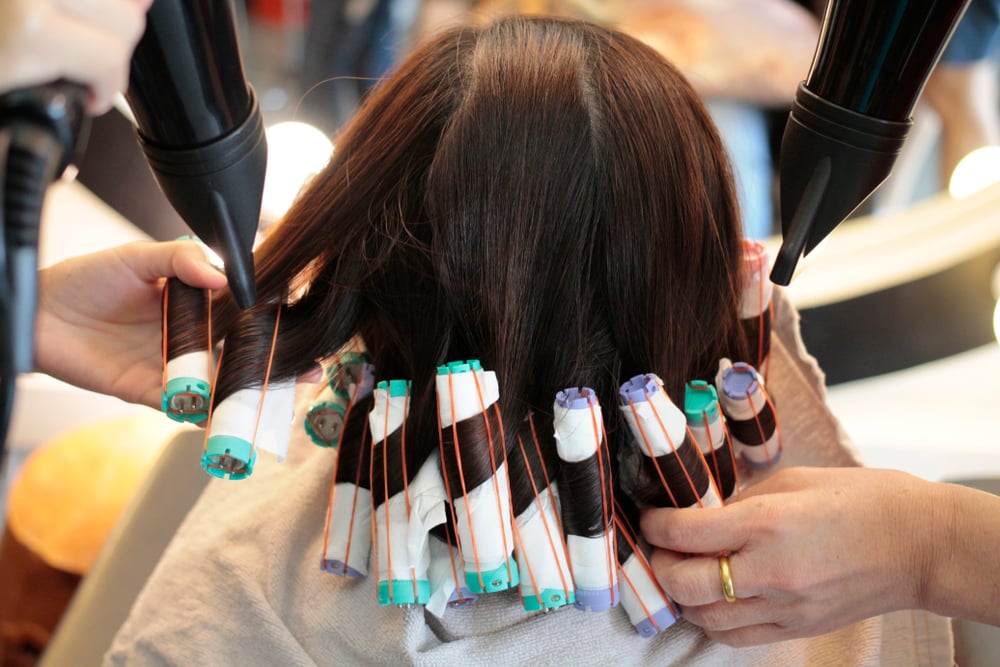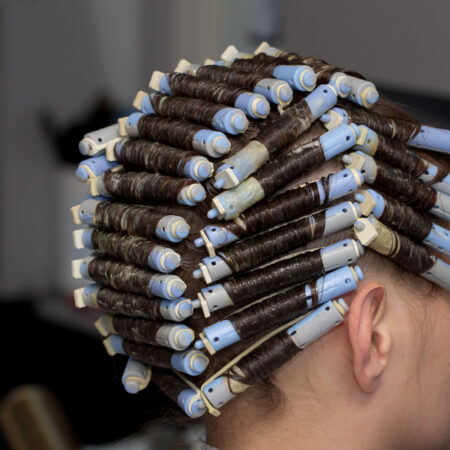Perms are a great way to alter the texture and volume of your hair, though they do have a reputation for being damaging to your locks. It’s also important to note that perms require specific steps and considerations to properly upkeep them. You should be aware of what goes into maintaining a perm before committing to this hairstyle to ensure it looks its best.
Our article gives you more information about how to manage your perm, and we answer important questions such as ‘can I wet my hair after a perm?’ and ‘how to care for your perm.’ Read on to find out everything you need to know.
- What Does a Perm Do to Your Hair?
- Can I Get My Hair Wet After a Perm?
- How to Care For Your Perm
- FAQs About Perms
- Are There Different Types of Perms?
- Are Perms Damaging to Hair?
- Which Hair Types Can Get a Perm?
- Who Should Not Get a Perm?
- How Long Do Perms Typically Last?
- How Do You Prepare for a Perm?
- Can You Straighten Hair That Has a Perm?
- Can You Get a Perm With Dyed Hair?
- Can You Get a Perm With Long Hair?
- How Much Do Perms Cost?
- Taking Care of Your Perm the Right Way
What Does a Perm Do to Your Hair?
While the most common type of perm is one that adds loose waves, bouncy curls, or volume to hair, straight perms are also an option to chemically straighten curly or textured hair.
Technically called ‘permanent waving,’ perms alter hair on a molecular level, chemically affecting the keratin proteins in your hair. The keratin is molded by the chemicals of the perm, allowing the bonds in the hair to be broken down and changed into a new shape.
Once the perm treatment is completed, bonds will be put back into the hair, and product will be applied so that the hair holds its new shape.
This chemical process of altering the keratin in your hair and creating new bonds is what gives perm treatments the reputation of being damaging to hair. Perms can be damaging when performed incorrectly, or when hair is already damaged or dry. When hair is thin and fine, it’s also more prone to being frizzy and damaged by the perm chemicals.
However, a perm treatment performed on healthy, virgin hair by a professional is unlikely to create severe damage to hair and can leave you with a healthy new style.
Speak to a professional if you are considering a perm, but are concerned about the long-term effects it may have on your hair.
Are Perms Really Permanent?
Even though ‘permanent’ is part of the name, perm treatments don’t last forever. Your hair will continue to grow after a perm has been received, and it will grow out as its natural texture.
You can get root touch-ups with a perm, but over time the perm will lose its shape at the bottom of your hair with regular haircuts. In general, you can expect a perm to last you around six months, with factors such as hair and scalp health, haircuts, and the speed at which your hair grows affecting this.
Can I Get My Hair Wet After a Perm?
While you can get your hair wet after a perm, it’s essential that you don’t wash your hair or get it wet until at least 24 hours have passed. Hair stylists and perm professionals generally recommend waiting between 24 and 72 hours to wash or wet your hair. This is in order to let the chemicals neutralize and the perm fully set in your locks.
Washing or wetting your hair immediately after a perm may cause the treatment to be ineffective and result in damaged hair or a partial treatment, both of which will ruin your new style.
Speak to the stylist completing your perm for their recommendations on how long to wait after treatment is completed to wet or wash your hair. Make sure to wait at least 24 hours before considering adding any kind of water to your perm.
How to Care For Your Perm
After your hair has been permed, you’ll need to keep the following in mind to make sure that you are maintaining your perm correctly and that your hair looks its best for as long as possible.
- Keep your hair moisturized after a perm has been received and utilize deep conditioning treatments when possible. Permanent waving tends to try hair out and may cause it to be damaged or frizzy; moisturizing treatments help to counteract this and keep your hair looking smooth.
- Consider using bond-building products to ensure your hair stays healthy while permed. Olaplex is one of the most popular brands for bond builders, and you can speak to your stylist about their recommendations for which product to use.
- Limit heat styling and additional chemical treatments, such as bleaching or dyeing, on your hair after a perm has been received. Adding these to hair that has already received chemical treatment and is already fragile may cause extensive damage and ruin the look of your perm.
- Sleep on silk pillowcases or wrap your permed hair in a silk scarf overnight to protect the hair from frizzing and tangling while you sleep.
- Be gentle with your permed hair and brush it while damp with a wide-toothed comb. This will help you get knots and tangles out without attempting to brush it while dry or with a heavy brush that might create breakage and frizz.
If you have any questions about perm maintenance or what you need to do in order to properly care for your perm, speak to your stylist about this before you receive your perm. Then, you’ll be completely informed about the upkeep of this hairstyle.
FAQs About Perms

Perms require a certain amount of maintenance and upkeep to ensure they look their best for the duration that you wear this style. Read our answers to several frequently asked questions about perms to put any lingering worries about this hairstyle to rest.
Are There Different Types of Perms?
While perms are typically conducted with a certain specific set of chemicals, this mixture may be adjusted based on your hair thickness and hair health. Alternatively, you may receive a thermal perm which combines heat treatments with certain chemicals to get the desired perm look.
Make sure to speak with your hairstylist about the best-recommended method of perming for your hair, including whether you should be getting a perm to make your hair straight or a perm to make your hair curly.
Are Perms Damaging to Hair?
Because of the chemicals used in the perm process, perms can be damaging to hair. This is especially true if the hair being permed is already dyed, chemically treated, or very thin and fine.
Oftentimes, your stylist will look at your overall hair and scalp health in addition to asking you questions about previous treatments you have received on your hair. This will help determine if a perm will have the desired results on your locks.
If you have healthy virgin hair (this means hair that has not been previously dyed or chemically treated), a perm is less likely to create serious damage, breakage, or frizz. This is especially when performed by a professional skilled with perms.
Which Hair Types Can Get a Perm?
Any hair type can get a perm, and you can use perm treatments to make your hair straight or add loose waves, tight curls, or volume at the roots of your hair.
Thicker and medium-length or shorter hair lengths typically hold perms the best, while thin or fine hair types do run more of a risk of being frizzy and damaged after a perm is received. However, this can be combated to some extent with moisturizing treatments and proper after-perm care.
Who Should Not Get a Perm?
Individuals that should maybe reconsider getting a perm include those with bleached hair, hair that is already chemically treated, or hair that is very dry and damaged. The chemicals used in the perm process are likely to create more damage and may bring about significant breakage in the hair.
Additionally, if the perm solution is accidentally applied too close to the root of damaged hair, it may contribute to hair loss.
How Long Do Perms Typically Last?
Perms usually last around six months, but this length does depend on how healthy your hair and scalp are, how well you take care of your perm, and how quickly your hair grows. Haircuts and other hair treatments, such as dyeing your hair or using heat styling tools may also affect the longevity of your perm.
How Do You Prepare for a Perm?
After you’ve booked your appointment for a perm, make sure to pay attention to any instructions that your hair stylist has for you.
You should avoid dyeing or chemically treating your hair at least two months ahead of your perm. Utilize a deep conditioning treatment around 72 hours before your appointment, and then don’t touch your hair at all within 24 hours of receiving your perm.
Can You Straighten Hair That Has a Perm?
Once your hair has been permed to be curly, you can straighten it with heat styling tools. However, it’s not recommended to do this often, as you will lose the look of the perm with constant heat styling and risk damaging your hair over time.
Can You Get a Perm With Dyed Hair?
While you can get a perm with dyed hair, this might not be recommended based on how healthy your hair is. Chemically treated and dyed hair may be more damaged and susceptible to frizziness or breakage after a perm is received. The perming chemicals may also lighten your hair another few shades or destroy the color of your hair.
Getting a perm without colored hair is preferred, but you should speak with your stylist if you are considering getting a perm while having dyed hair.
Can You Get a Perm With Long Hair?
Perms with long hair are possible, but they are less likely to hold very bouncy or tight curls. This is because the length of very long hair makes the perming process more difficult and requires much more effort when it comes to curling every strand of hair.
If you have long hair and want to get a perm, make sure to consult with a stylist who specializes in perms for long hair or someone who has previous experience with this.
How Much Do Perms Cost?
Perms are not the cheapest treatment. The exact price of a perm may vary depending on your location, the type of stylist or salon you visit, your hair length, and what is needed to make your perm successful.
On average, you can expect to spend between $50 and $400 on a perm, with long hair or hair that needs more careful perm treatment being more expensive.
Taking Care of Your Perm the Right Way
Perms are a great way to change the overall texture of your hair and give yourself a brand-new style. However, you should be aware of the potential damage a perm can cause and all of the steps that go into maintaining your new style.
Make sure to speak with your stylist and get your perm done professionally. This will ensure your perm looks the best and that you know exactly what the perming process will be like, so you can take care of your perm the right way.
